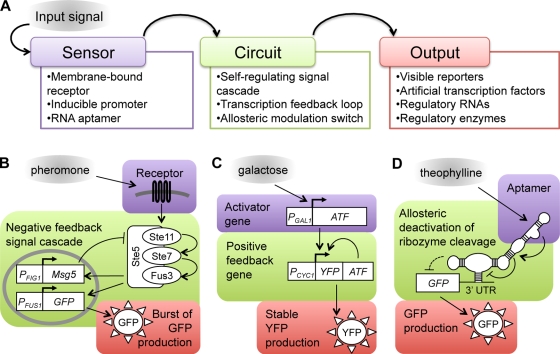Figure 2.
Three levels of modular functions within synthetic devices. (A) An input signal, such as a small molecule, ligand, or metabolite, is detected at the sensor level. The signal is then translated into a pattern of behavior at the circuit level. At the output level, reporter gene expression and/or effectors of downstream processes coincide with the behavior of the circuit. Each box lists examples of sensors, circuits, and outputs that are correspondingly shaded in B–D. (B) In a cell signaling–based device, pheromone input binds a receptor and triggers an engineered MAPK signal circuit that activates GFP expression and the negative regulator Msg5. Activation, negative feedback, then deactivation result in a burst of GFP output (Bashor et al., 2008). (C) In a transcription-based device, transient galactose input induces the expression of a PGAL1-driven ATF that initiates the stable transcription of a positive feedback gene and sustained YFP output (Ajo-Franklin et al., 2007). (D) Functions of a riboswitch are encoded within folded RNA domains. Theophylline input binds to the aptamer sensor region, causing a conformational change that is transduced down the molecule to disrupt ribozyme-mediated RNA cleavage and allow GFP expression (Win and Smolke 2007, 2008).

